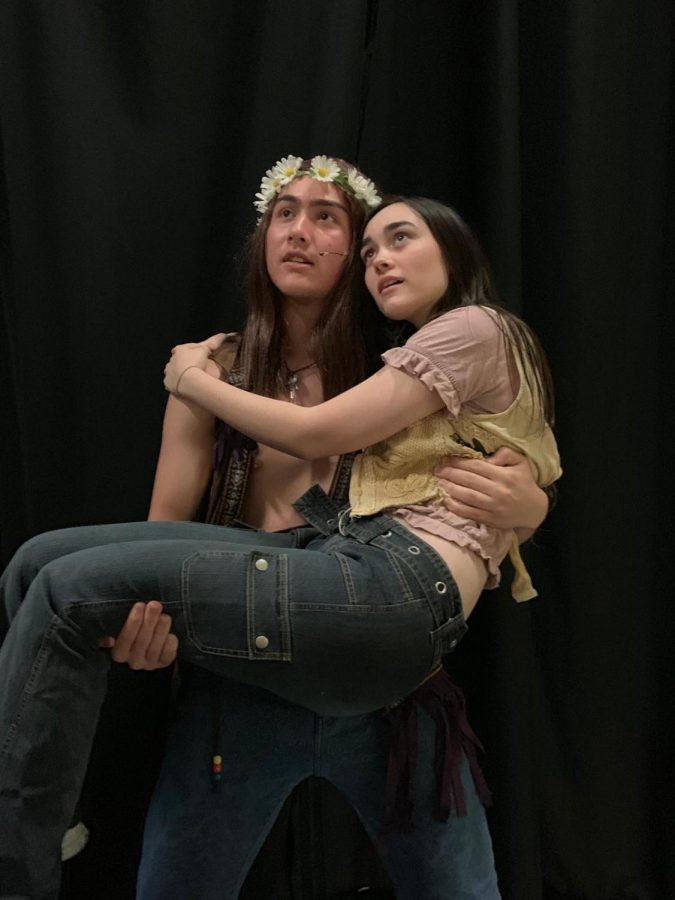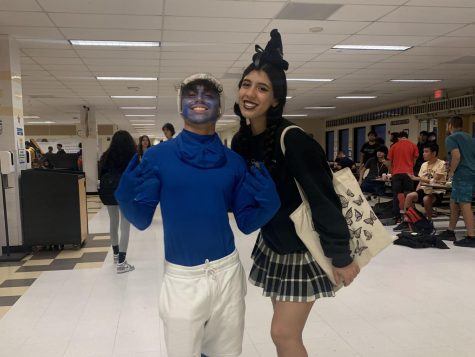Hair: the musical boasts talented ensemble on and off stage
Julia Pihokken (Sheila’s understudy) and Aidan Havens (Berger) rehearse on March 11.
In the dim school hallway, the only signs of life come from a single door. Voices can be heard singing, commanding and conversing. Through the small window on the door, students are seen frantically polishing their lines. Tonight is the Drama Club’s last performance of “Hair: The Musical.” Before students file in to the auditorium to experience this flashback to the era of hippies and flowing locks, the club members prepared for weeks to perfect their art.
Focused on the Vietnam War and the culture surrounding it, “Hair” ran March 14-16. Some of the main characters include Claude (junior Roman Amento), Berger (junior Aidan Havens) and Sheila (senior Ashley Shrewsbury, understudied by junior Julia Pihokken).
Drama teacher and director Oliver Black said he chose this musical because of the timeliness and the topics discussed.
“Youth today are very outspoken as were the kids and the youth that put on ‘Hair’. With today’s political climate, it is a positive show for the kids to help them realize they still have a voice,” Black said.
During musical rehearsals, vocal coach Marissa Jefferson comes in to do warm-ups and goes through the songs. Isabella Canizares, an ensemble member who sings a solo, has worked with Jefferson in the past.
“She has helped me a lot with my solo, in ways I didn’t know I really needed help with, like [to] open my mouth wider or make sure to hold my diaphragm,” Canizares said.
Alongside vocal coaching, the performers must also practice their dance numbers. Student choreographers Alexis Dixon and Michael Carrillos are a vital part of training the performers.
Dixon said their roles are to make sure the cast knows the choreography well and everyone knows what they are doing on stage.
Playing the main role, Amento said his process of becoming Claude was accomplished through watching a lot of Vietnam War movies, but he chose not to watch “Hair” because he didn’t want that to influence his way of working with the character.
Fellow cast member Havens, who plays Berger, believes Hair’s comedic elements allowed the cast to be more flexible with how they portrayed their characters, in turn making the performance more enjoyable than previous shows he has been in.
As as understudy for Sheila, Pihokken agreed with Havens and said they were more free with characterization.
Havens and Pihokken both added that they experienced new levels of group bonding through rehearsals and became better friends in general with other cast members.
“We’re more affectionate [with each other] now because in the show we had to be affectionate. The show is all about free love and it translated into real life for us. If you love another character [in the show], you love them in real life,” Pihokken said.
She can relate to her character Sheila because she is “really passionate and cares about social issues [and] she wants to make a change in the world.”
Despite the upbeat and funny cues of the play, the underlying theme reflects real world issues.
“It is really serious because it is about things that could happen and have happened… We still have wars going on, people still hate other people, we still have racism and homophobia; there is still so much hate and this show is trying to combat that hate,” Pihokken said.
Another member of the main cast is Gaby Kouras, who not only performs in the show as Margaret Mead, but also fills the newly added role of Tech Lead. Kouras assigns certain tasks to the stage managers and the tech crew, who control lighting, sound and stage assembly.
Even though the stage crew isn’t the main focus for the audience, they are the driving force of the show. Without them, it would be too dark to see, too quiet to hear and essential elements of a play would be missing.
Juniors Anna Forst and Cory Gershengorn are the stage managers and oversee all details of rehearsals. They take notes on the events of every rehearsal, take attendance and are in charge of all the different technical aspects.
Despite not performing in the play, Forst has a deep passion for the production of drama that can be traced back to her grandparents, as they were both involved in theater. As a child, she attended numerous plays and realized her interest in theater when she went to her first Broadway show, “Wicked.”
“And that’s when I knew that I loved this [theater]. I never had a way of pursuing that because I can’t really carry a tune, [and] dancing has never been my thing. I probably could act but I never tried it. Then I was like ‘oh I can do tech like my grandparents did’,” Forst said.
Sitting in the audience, it is important to note, there is much more to a performance than meets the eye. Behind the catchy show tunes, there is an ambitious vocal coach; behind the intricate dance moves, there is a creative choreographer and behind the captivating set design, there is a resourceful tech team, but most importantly, behind every thespian, there is an unwavering devotion to an art form that continues to thrill viewers from generation to generation.









